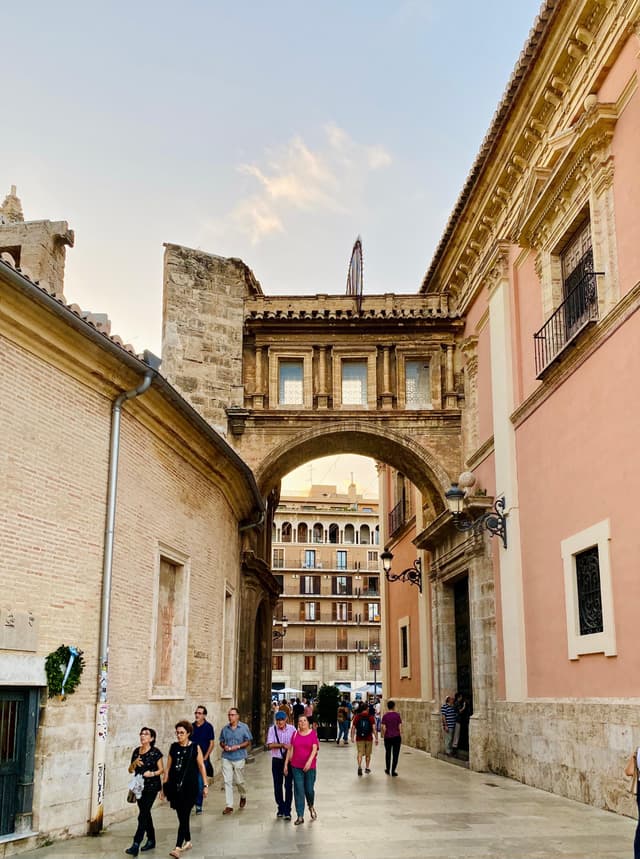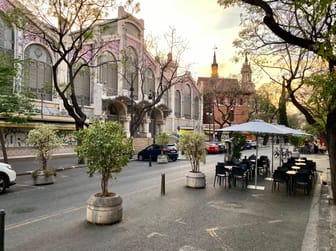EAT + DRINK
SEE+DO
CIUTAT VELLA
Valencians call their historic central district La Ciutat Vella. The Old City, as the 1st district's name translates in Valenciano (the local language similar to Catalan), is comprised of 6 neighborhoods or barrios: El Carme, La Seu, La Xerea, Sant Francesc, El Mercat, and El Pilar.
Map creator: Mike Hall on Behance.com
Always check hours and closure days. Keep in mind that Spanish days start later—many sites don't open until 10 am—but markets open (and close) early. Rearrange to suit individual needs.
Focus on La Seu, the cathedral neighborhood of La Ciutat Vella.
La Seu
In the heart of Ciutat Vella, the neighborhood of La Seu is aptly named for the cathedral that proudly stands between two large plazas and among numerous other churches and smaller plazas. The streets and plazas are magical at night. We spent many evenings strolling through the Cathedral district, warmly lit to highlight its architecture and monuments.
To continue from El Carmen, cross Carrer dels Cavallers to first stop at the Church of Saint Nicholas tucked away on the left.
✨ MUST-SEE HIGHLIGHT: See the impressive Baroque frescos inside San Nicolas.
Parroquia de San Nicolás
@aligiaudrone
This church is tucked away where El Carme meets La Seu. Called Valencia's "Sistine Chapel" for its ornate Baroque frescos that cover nearly every inch of Sant Nicolau de Bari i Sant Pere Màrtir (the Valencian name of this church), it's closed to the public on Mondays. This parish church was among the first of twelve built after the Christian reconquest of Valencia from the Moors by Jaume I of Aragon in 1238.

Details
Return to Carrer dels Cavallers, then turn right to continue east to the Palace of the General Council. At one end is Plaça de Manises; at the other end is the garden bordering the glorious Plaça de la Mare de Déu (aka. Plaça de la Virge), one of my favorite spots in the city.
Palau de la Generalitat Valenciana
@aligiaudrone
This Gothic palace dates back to the 15th century when it was constructed as a tax office to the crown. Today the complex and garden serve as the headquarters of the Valencian government.

Details
Plaza de la Virgen
✨ MUST-SEE HIGHLIGHT: This plaza comes to life at sunset emanating a warm glow as the bell rings.
Plaça de la Verge
@aligiaudrone
Quite possibly my favorite spot in the city to relax, this plaza is divine. Literally. Two major churches flank the Plaça de la Verge (the Valencian name), once the Roman forum.
La Seu, the cathedral, sits at one end with the pink Basilica flanking the side of the plaza, both connected by a covered archway passage. In the evening the entire square and its architecture glow in warm lamp light.
Opposite the churches is the garden of the Palau de la Generalitat Valenciana, the headquarters of the Valencian government.

Details
Basílica de la Mare de Déu
@aligiaudrone
Known in the Valencian language as Basílica de la Mare de Déu dels Desemparats, the basilica in Plaza de la Virgen was built on the site of an old Roman temple. Constructed over many years, the result is a unique blend of Baroque, Rococo and Neoclassicism and connected by a covered archway passage to the La Seu, the cathedral at the end of the plaza.
The fountain is the Font de Túria, which depicts the Roman god Neptune to represent the Turia River that once surrounded the city. After the catastrophic Great Flood of 1957, La Turia was diverted to create a green space that flows around the old city in its bed.

Details
Valencia Cathedral
✨ MUST-SEE HIGHLIGHT: Walk the entire perimeter of the Valencia Cathedral, La Seu.
Valencia Water Tribunal at the Cathedral
@aligiaudrone
Each Thursday outside La Seu, at the cathedral's west transept doors, the Water Tribunal (Tribunal de les Aigües de València) meets to mediate canal use throughout Valencia's fertile plains, La Huerta (L'Horta in Valenciano, Valencia's regional language similar to Catalan).
The gardens of La Huerta have been continuously cultivated since the 10th century when Islamic Moors created the irrigation system and established the tribunal, which is still in use and protected as UNESCO Heritage. The efficient proceedings of the local farmers voted into the tribunal every two years are conducted in traditional Valenciano and all decisions are final.

Details
El Micalet
@aligiaudrone
Dong... Dong... Every 15 minutes a beautifully deep resonant bell rings throughout Valencia's old center. Its source is a large, heavy bell atop El Micalet, the Valencian Gothic-style bell tower connected to La Seu, the Cathedral.
The unique blunt top and octagonal shape of El Miguelete, as it's called in Spanish, rises above the rooftops. The tower's base connects to the corner of the cathedral at its front narthex entrance.

Details
La Seu (Valencia Cathedral)
@aligiaudrone
La Seu, as the Valencian Gothic cathedral is simply called, was originally the Great Mosque of the Moors. In the 13th century when Christians took over, they converted the site into a church by adding its east-facing Romanesque doors.
Continued development of this cathedral looked to erase signs of Moorish rule, though Islamic influence is seen in Valencian Gothic architecture's organic geometry that was constructed by the city's remaining Mudéjar artisans. Baroque additions, such as the ornate Puerta de los Hierros entrance at Plaza de la Reina, were later added.
Enter through the east transept doors at Plaza de la Almoina to see the gilded interior, especially evident in the chapels and apse, clad during the Baroque period. The original Valencian Gothic style is seen in the stone tracery, ribbed vaults, and pointed arches of the central nave.

Details
Cathedral Archway Passages
@aligiaudrone
A covered passage archway, Passatge d'Emili Aparicio Olmos, connects the Basilica to the Valencia Cathedral. On the other side is Plaça de l'Almoina where another archway leads to the Archbischop's palace.
La Seu, as the Valencian Gothic cathedral is simply called, was originally built as a mosque. The influence of Moorish rule during the Middle Ages is seen in its design and construction through Mudéjar Islamic organic geometry.

Details
Walk under the covered archway connecting the basilica and the cathedral to a plaza at the cathedral's Romanesque entrance, home to Valencia's Archbischop and parochial offices.
Arquebisbat de València
@aligiaudrone
The headquarters of the Valencian Archdiocese surround Plaça de l'Almoina. La Seu stands on one side at the transept entrance. An archway passage above connects with El Cabildo and the Archbishop's Palace offices.

Details
Under the second archway connecting the Archbishop to the Cathedral, a passageway leads to Plaça de la Reina, a large, bustling plaza surrounded by many shops and restaurants. At this end, El Micalet stands by the Baroque cathedral entrance doorway with the tower of Santa Caterina at the other end.
✨ MUST-SEE HIGHLIGHT: Visit the newly renovated Plaza de la Reina.
Plaça de la Reina
@aligiaudrone
Plaça de la Reina now provides a new central vantage point to enjoy a view flanked by the Micalet and the baroque door of the Cathedral at one end and the Santa Caterina tower at the other.
This plaza has been completely pedestrianized paved with non-slip limestone to prevent heat absorption. A 115-tree urban forest surrounds benches over a renovated underground two-story parking garage. A huge removable awning installation protects from the harsh Valencian sun in the hot monthas and provides ideal outdoor restaurant seating.

Details
An arched hallway between the buildings of the plaza leads into the tucked away Plaça del Miracle del Mocadoret surrounded by charming shops like the Valencian ceramics store of Artesanía Yuste. A maze of corridors leads back out to the church plaza and tower of Santa Caterina at the south end of at Plaça de la Reina.
Artesanía Yuste
@aligiaudrone
This region is particularly known for ceramics. Artisans craft Valencian ceramics in this shop and display an array of tiles and bowls that feature traditional designs.

Details
Church of Santa Caterina
@aligiaudrone
The tower of Santa Caterina can be seen from various city angles and has a particularly radiant warm glow at night.

Details
El Carme (El Carmen)
Stroll the narrow medieval streets of Barrio del Carmen, the old quarter between the two medieval tower gates. Visit the museums or walk from plaza to plaza casually peruse street art. Nightlife here is vibrant among its many restaurants, cafes and tapas bars.
El Mercat + El Pilar
Since the time of the Moors, El Mercat, the area around the Market has served as a buzzing marketplace and trade center. Today Mercat Central offers fresh goods. Continue westward into the mostly residential neighborhood of El Pilar away from the main monuments of Ciutat Vella.
Sant Francesc + La Xerea
The spacious Sant Francesc neighborhood on the south end of Ciutat Vella, filled with great restaurants and quaint streets, is home to City Hall. La Xerea (pronounced "shayr-AY-uh”) is a livable neighborhood in the eastern corner of Ciutat Vella packed with understated history.
Beyond the Center
Valencia has so much more to explore beyond Ciutat Vella. Be sure to stroll along the greenspace of Turia Gardens that flows through the city. Shop its other markets. Tour its soccer (fútbol) stadiums. Venture over to its Mediterranean beach communities and out to its nature preserves.
FOLLOW ME
* * *










_1024.jpg?itok=LnZLXX5K)









